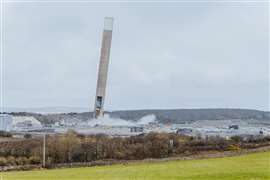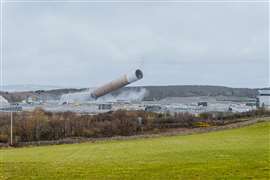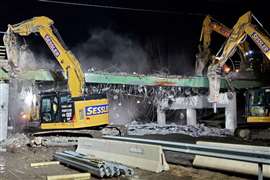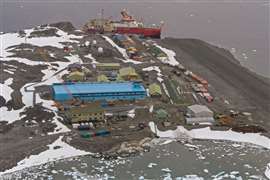Read this article in 中文 Français Deutsch Italiano Português Español
Total Reclaims downs 122-m Holyhead chimney stack
02 April 2024
Total Reclaims Demolition (TRD) has brought down a 122-metre-high chimney at the retired Anglesey Aluminium smelting plant near Holyhead, Anglesey, in the United Kingdom.
Anglesey Aluminium was closed in 2013, having produced around 140,000 tonnes of aluminium every year since 1971. At the height of its operations, the site was “the biggest single user of electricity” in United Kingdom, utilising around 255 Mega Watts per annum.
 (PHOTO: Total Reclaims Demolition)
(PHOTO: Total Reclaims Demolition)
Its concrete chimney - a local landmark that had stood at the plant for over 50 years and was previously one of the tallest structures in Wales, was taken down on 20 March via controlled explosive event.
TRD toppled the chimney, which was reinforced with an internal steel flue, by first pre-weakening the structure.
TRD said: “Due to the height of the chimney, it was constructed with a significant amount of reinforcement and, for the chimney’s trajectory to be accurately predicted, a large section of the reinforcement was cut on the northwest face.
“This along with the locations of the existing openings within the chimney’s base, which conveniently formed the “hinges” determined the angle that the chimney would fall and its subsequent resting place.”
The demolition contractor also formed a window in the southeast face of the chimney, in the direction of fall. and 156 holes were diamond drilled in a set pattern.
It then used a total of 20 kg of TNT to carry out the felling, with 125-gram charges packed into 156 individual diamond-drilled holes in a set pattern.
“These charges were grouted and connected via approximately 120 m of denotating cord back to a central point at the bottom of the chimney,” said TRD.
 (PHOTO: Total Reclaims Demolition)
(PHOTO: Total Reclaims Demolition)
According to the demolition contractor, the close proximity of RAF air space, adjacent Network Rail passenger and freight lines and the required temporary closure of two nearby major road arteries, meant that it had only “a 15-minute window of opportunity” to commence the blowdown.
Speaking on behalf of Total Reclaims Demolition, Stephen Fisher, said: “The day went perfectly as planned, and it was with thanks to the entire team that was not only present on the day, but all those that assisted in the planning of it.”
The blast was the culmination of 15 weeks of enabling works.
As part of its contract with Stena Line, TRD also cleared the site’s remaining smelting works and four storage sheds.
“The four storage sheds and smelting works were primarily steel portal frames, clad in aluminium,” said TRD.
“The sheds were run of the mill type of work. Although, at 480m long and 22m wide they were vast, generating around 6000 tonnes of scrap ferrous and non-ferrous metal.”
STAY CONNECTED


Receive the information you need when you need it through our world-leading magazines, newsletters and daily briefings.
CONNECT WITH THE TEAM













